The Walking Wounded: A long touring career can come at a physical cost
Mark Davis and other veteran anglers explain why playing through – and preventing – pain is just as important in bass fishing as any other sport.
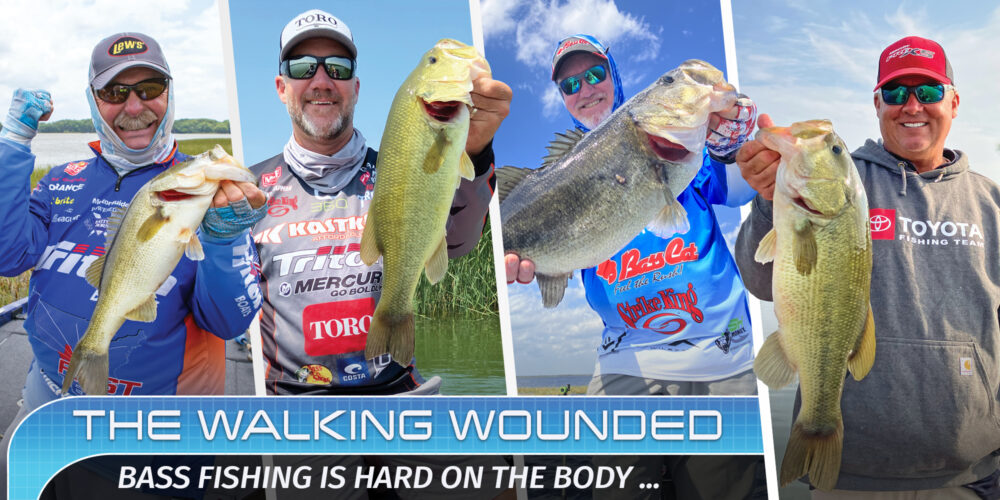
The first time Mark Davis arrived at the hospital for surgery, his doctors tried to talk him out of it.
It wasn’t that Davis didn’t need the procedures. The pain emanating from the Bass Pro Tour veteran’s right shoulder and left elbow had gotten so bad that he couldn’t wield either casting or spinning gear without discomfort. The problem was Davis attempted to get both limbs repaired at the same time.
This being the mid-1990s, before medical records were digitized, the two separate specialists he had seen about each ailment didn’t realize until they arrived at the operating room that Davis had actually booked both for the same day.
The doctors warned Davis that, if he went through with his plan, he’d be without use of both arms for weeks while he recovered. They were right, by the way. Davis remembers feeling “completely helpless” afterward, relying on his wife, Tilly, for everything – even using the restroom.
“I was an invalid, pretty much,” he said. “I remember when I woke up, they had me wrapped up like a mummy in a straitjacket. I didn’t have use of either arm.”
But Davis, at the time less than a third of the way into his Hall of Fame career, felt like he didn’t have a choice. If he didn’t address both injuries early in the offseason, he might have to miss the start of the following tournament year, and he couldn’t afford to do so.
“(The doctors) both walked in and said, ‘Hey, we don’t need to do this,” he recalled. “I said, ‘Yeah we do. I don’t have any choice. We’ve got to get it done, and I’ll just suffer through it. I’ve got to get it done and get rehabilitated and get back going before the season cranks up again.’”
Fast-forward more than 20 years, and Davis has put together one of the most decorated careers in tournament bass fishing history. In his 37 seasons on tour, he’s notched six wins, including a victory at the 1995 Bassmaster Classic, and three Angler of the Year titles. But to get there, he’s had to persevere through an equally impressive litany of injuries.
Since those first surgeries on his right shoulder and left elbow, Davis, now 60, has undergone a second surgery on his right shoulder, another on his left shoulder, a hip replacement and a three-level fusion in his neck.
Davis is proof that a long angling career comes with a physical cost – and that preventing, toughing out and treating injuries is just as much a part of bass fishing as any other sport.
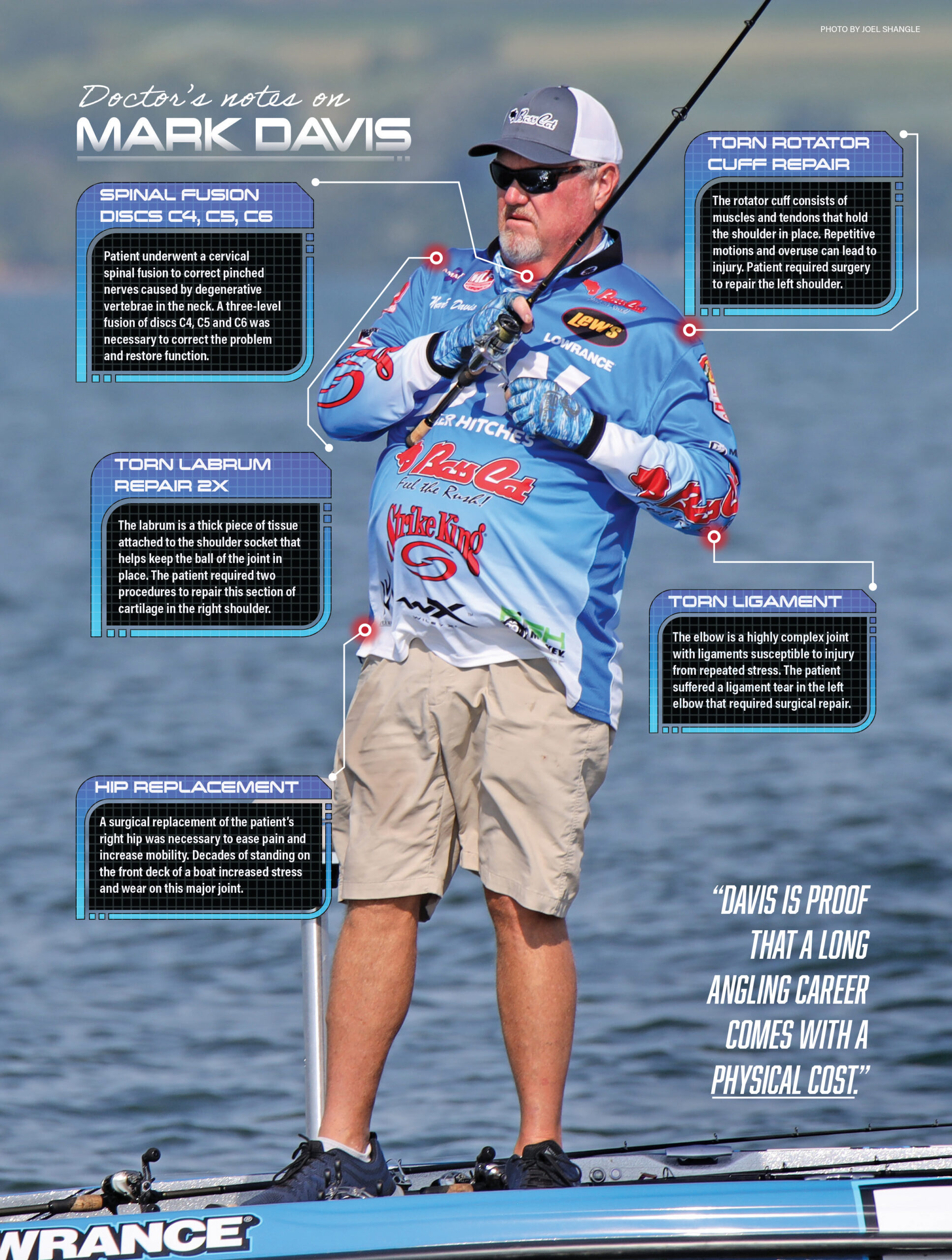
The toll of the tour
Shaw Grigsby can’t recall the last time he fished without pain. The Tackle Warehouse Invitationals pro estimates it’s been 20 years, at least.
Grigsby, who completed his 40th season on tour in 2023, might be the one angler who can rival Davis in terms of injury history. He’s undergone two back surgeries, two shoulder surgeries and one each on his knee, thumb and hip. That doesn’t include a pair of serious non-injury procedures: a triple bypass in 2004 and an operation to remove cancer from his kidney in 2020.
That list might shock those who don’t closely follow the professional circuits, who view fishing as a relaxing pastime. After all, it’s not a sport that puts a premium on physical traits like size, strength or speed. Davis has often struggled to explain to those unfamiliar with the sport why he’s experienced so many ailments – including some of the doctors treating them.
“People who don’t know anything about the sport, they’re like, ‘Oh man, you fish for a living? I bet that’s great,’” Davis said. “I tell those people, I say, ‘Yeah, you ought to try it sometime.’ They have no idea.”
In reality, the cause of most anglers’ injuries is no mystery: The hundreds of hours they spend each year casting, being jostled by waves and driving their boats or trucks add up.

“Most athletes go play a game for an hour or two,” Bass Pro Tour veteran Brent Chapman explained. “On a tournament day, (we fish) 7 ½ hours. On practice days, it’s 12, 14, 15 hours. And then when we’re not doing that, we’re driving for ridiculous amounts, which is horrible for your body.”
Monte Ketchum, a non-surgical sports medicine physician for Andrews Sports Medicine, has treated several BPT pros during the past 10 months. Andrews Sports Medicine partnered with the Major League Fishing Anglers’ Association during the 2023 season, allowing Ketchum and fellow physician Daniel Smith to provide on-site consultations and care at two BPT events and treat a handful of anglers at their three Alabama clinic locations. Ketchum said the most common ailment he’s observed is inflammation to anglers’ shoulders, elbows and wrists due to repetitive use. Several pros, including Chapman, cope with arthritis in their joints.
Over time, the repeated motion can lead to torn muscles, tendons or ligaments. Davis knows that all too well. He’s confident that a distinct cast he used to throw light lures on a baitcasting setup is the reason he’s torn the labrum in his right shoulder twice. He’s also torn his left rotator cuff and a ligament in his left elbow.
“It was a real powerful, underhanded roll cast, and I could cast a light lure and keep it real low to the water – like a little, small jig or little popping bait that I could cast under these bushes and under these boat docks,” Davis said. “It was a hard, a high-velocity cast. … And when you extend your arm out and then come around and down with it, and you do it abruptly and do it hard and fast, your shoulders aren’t made to do that. But here I was doing it day in, day out, and I had to quit casting that way. I just quit. After two surgeries, you’re like, ‘Yeah, I’m going to change that.’”
Meanwhile, hours spent standing on the front deck can lead to back, hip and knee injuries. Davis and Grigsby have both undergone hip replacements, while Grigsby also had a torn meniscus in his knee surgically repaired. Davis said doctors told him his right hip looked like that of an 80-year-old while his left hip looked like it was 30. He believes that’s a result of spending years standing with his right foot on a trolling motor pedal in the days before Spot-Lock.
Fellow BPT pro Terry Scroggins has had both knees replaced within the past three years. While the 55-year-old believes his knee issues predate his fishing career, years of bouncing in waves and bending down to land fish exacerbated the wear on them.
“We do take a beating in the boat, especially when we go up north,” Scroggins said. “We get out there, get jarred around over and over and over, and the practice days are so long. They’re 14, 15 hours, sometimes longer than that – just however long you want to stay out there. And it pays a toll on you. I don’t care if you’re 20 years old or 50; over time, it’s going to get you.”
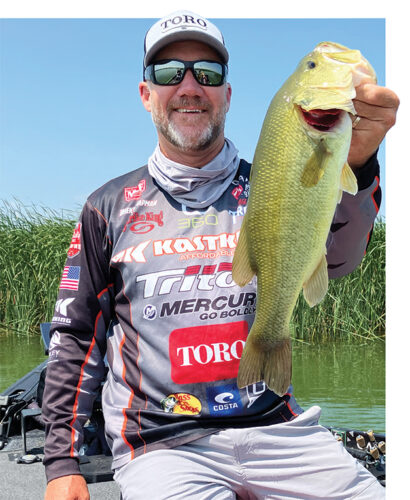
Playing through pain
Out of all the ailments he’s experienced, the one that scared Davis most, that he wasn’t sure he could endure, was the least painful.
Davis started the first morning of a 2012 Bassmaster Elite Series event at Oneida Lake dragging a jig offshore. After setting the hook on a sizable smallmouth, he tried to fight the fish, but his fingers wouldn’t cooperate. He felt no pain, yet he couldn’t get a strong enough grip to turn the handle of his baitcasting reel. The bass eventually threw the jig, and Davis panicked; thoughts of ALS or some other career-threatening disorder creeping into his mind.
“I just was sitting there in the boat, and it dawned on me, something is bad wrong with me, and I don’t know what it is,” Davis said. “In your mind, you start thinking, oh my gosh, I have Lou Gehrig’s Disease. I’ve got who knows what wrong.”
Ultimately, Davis found out he had three degenerative vertebrae in his neck, resulting in pinched nerves, which necessitated another operation. But first, he switched entirely to spinning tackle and finished the tournament (finishing 26th out of 97 competitors), plus fished the MLF Summit Cup on Chautauqua Lake the following week.
It wasn’t the first time in his career Davis had to adapt his fishing based not only on the conditions and cover, but his body. He also used exclusively spinning gear during the 2001 Bassmaster Classic on the Louisiana Delta – a power fishing paradise – due to one of his shoulder injuries.
Davis’ experiences might be extreme, but he’s far from the only touring pro to grit through injuries, even as they impacted his ability to put fish in the boat. Ketchum noted that several of the anglers he’s worked with said they’ve been battling pain for years, and they often don’t seek medical help until it becomes unbearable.
“These guys are tough, man,” he said. “They’re not coming in unless they’re just absolutely miserable, and even when it’s like that, they can’t take the time off, and so they just keep plugging along.”
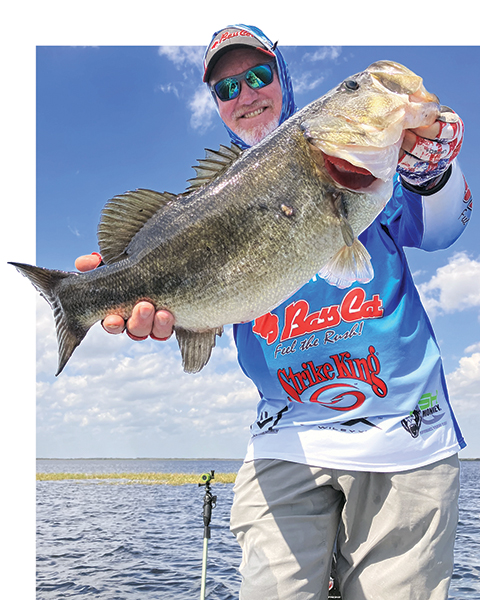
Several anglers pointed out that, even if it doesn’t limit them from a technique standpoint, dealing with chronic pain makes it difficult to stay focused, and thus to make good decisions on the water. Chapman credits a stretching and exercise regimen that he adopted following the 2011 season for alleviating his back pain and helping boost him from a 36th-place finish in the season-long standings for the Elite Series to an Angler of the Year title in 2012.
Scroggins, who tried to manage his knee pain using cortisone shots for several years, said he’s both feeling and fishing better after his surgeries.
“It was just hard getting up and down in the boat, everything was hurting, and you get in rough water, you couldn’t stand there like you normally would,” he said. “And when you’re competing at that high level, when everybody else is so good, you start hurting a little bit like that, your mind’s not functioning right, and things just don’t work right.”
According to Ketchum, there’s a simple fix for the issues ailing most anglers: rest. But during the tournament season, that’s not an option many are willing to consider. Time on the water is everything to touring pros, and sitting out events not only costs them potential paychecks in those tournaments but could limit their opportunities the following season. With seven events in the BPT regular season, scoring zero points in one of them makes qualifying for REDCREST difficult and losing a spot on the tour roster a real possibility.
“To stay competitive, you can’t miss stuff,” Grigsby said. “It’s not like a golf tour where the golfer, if he’s good, he can participate in X amount and make enough money in those tournaments that he stays qualified. In fishing, you have to fish them all.”
How to avoid the operating room
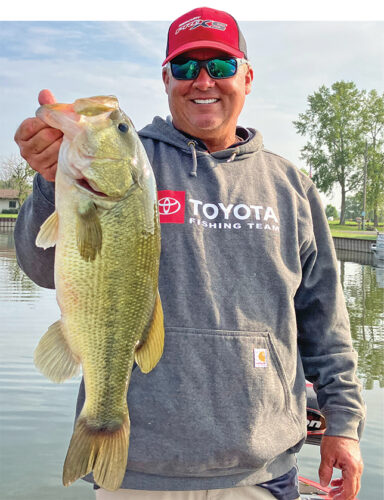
Do the experiences of Davis and Grigsby mean everyone who wants a long career should prepare to become friendly with their local orthopedic surgeon? Thankfully, no. There are things anglers can do to limit their pain and avoid trips to the operating room.
For one thing, modern technology has made fishing easier on anglers’ bodies. In addition to Spot-Lock taking the burden off his right leg, Davis believes the advent of hydraulic steering and longer-handled, lighter rods have reduced wear and tear on anglers’ arm joints.
“No one uses a pistol-grip rod anymore, but we used to use them all the time,” he said. “I remember cranking all day with a pistol grip. Can you imagine the torque on your wrist – and if it’s on your wrist, it’s also on your elbow – of doing everything with a little, short-handled rod?”
Exercise science has also come a long way during Davis’ career, and he believes young anglers would be wise to take advantage by incorporating some sort of mobility and stretching routine. Ketchum agrees. While medicines and injections can help anglers cope with repetitive-use ailments, the best thing they can do is try to prevent them by increasing flexibility and building muscles around their joints.
“The key is the preventative side, because we know we’re going to get the use during the season,” Ketchum said. “If they can do a lot of this rehab and strengthening prior to the season and come in in pretty good shape with it, that’s going to greatly decrease their risk of having issues throughout the year.”
Chapman is walking proof of that. At one point, he was prescribed pain medication to manage the arthritis in his left shoulder, and his doctor recommended he undergo surgery. Viewing that as a last resort, he instead tried out a daily, 10-to-15-minute exercise routine recommended by his friend Travis Perret, the proprietor of Exercise Therapy of Kansas City. Nearly a decade later, Chapman is still using the regimen, and he’s mostly pain free.
“The best advice I think I could give a young angler, or any angler, is there’s some maintenance.”
– Mark Davis
“I’m 10 years older, but really I’m more flexible than I was at 39, and knock on wood, I don’t have any pain to speak of,” Chapman said. “So yeah, it’s pretty amazing how just a little, simple routine can make a world of difference.”
Davis and Grigsby have incorporated similar regimens in recent years to minimize further wear on their joints. More than any technique tip they’ve picked up during their combined 77 years on tour, the two veterans advised aspiring anglers to remain diligent about their health. Staying active (it doesn’t have to be through traditional workouts, per se; Grigsby said he gets a lot of his physical activity by helping a friend capture nuisance alligators) and incorporating regular exercise routines has helped extend both anglers’ careers. They only wish they’d done so sooner.
“The best advice I think I could give a young angler, or any angler, is there’s some maintenance,” Davis said. “Just like we have to maintain our equipment, but we tend to ignore our bodies. But there certainly is some maintenance we could be doing that, if they know what to do, it could possibly prevent a lot of the stuff that’s happened to me.”